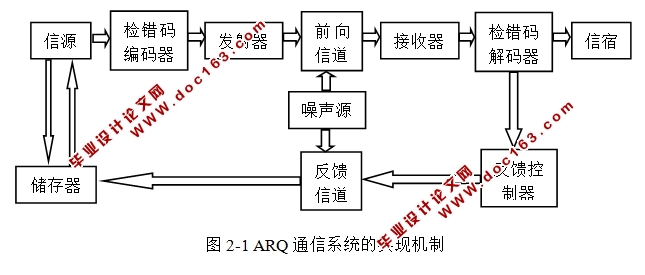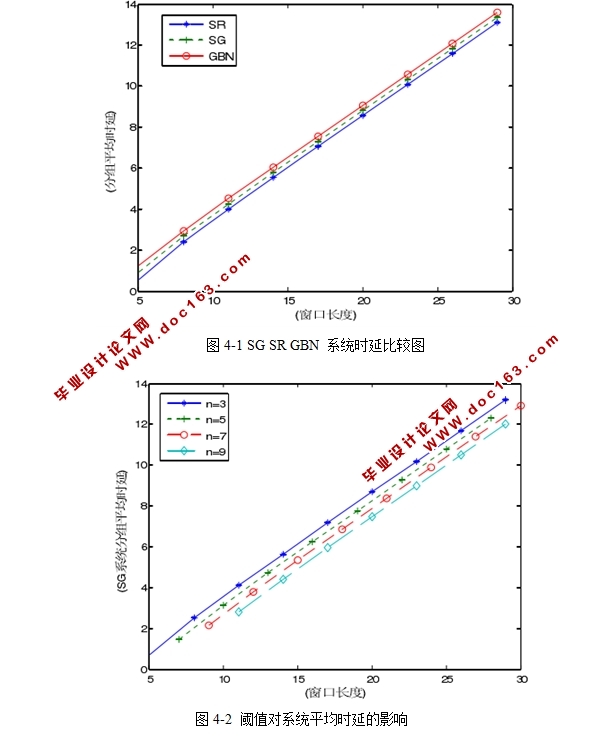基于ARQ的数字通信系统纠检错方法设计

1.无需注册登录,支付后按照提示操作即可获取该资料.
2.资料以网页介绍的为准,下载后不会有水印.资料仅供学习参考之用.
密 惠 保
基于ARQ的数字通信系统纠检错方法设计(课题说明书,开题报告,中期检查表,论文10000字)
摘 要 本文首先介绍了三种基本的ARQ方式,其次了解大数判决算法,对在单个数据帧副本中发生错误的概率与通过使用大数决策算法获得的重组数据帧中发生错误的概率进行了对比,最后提出了三种改进型 ARQ 方案:第一种是适用于高误码率环境的改进型停止等待 ARQ方案,本文对重传前、重传1次、重传两次和最后一次大数决策后的帧错误率进行了分析比较,第二种是对原始的 Moeneclaey 停等式ARQ 系统基于大数决策算法改进,并对这两种改进型方案与原方案的链路吞吐效率进行了比较,该方案保证了链路利用率,第三种是能有效地控制时延的自适应ARQ系统,并对该系统的延迟、丢包率、吞吐量等性能进行了分析。通过对以上三种方案性能的仿真分析,总的来说,第三种方案性能是最好的。
关键词 ARQ; 数字通信系统; 纠检错
Error Correction Method of Digital Communication System Based on ARQ
Abstract Firstly, three basic ARQ schemes are introduced. Secondly, the probability of errors in a single copy of a data frame is compared with the probability of errors in a reorganized data frame obtained by using a large number decision algorithm. Finally, three improved ARQ schemes are proposed. The first one is an improved stop-wait ARQ scheme for a high bit error rate environment. In this paper, the frame error rates of the ARQ system with the original Majority Decision Majority Stop Equality are analyzed and compared. The second one is the improvement of the ARQ system based on the Majority Decision Majority Decision Majority Decision Making algorithm, and the link throughput efficiency of the two improved schemes is compared with that of the original scheme. The scheme guarantees the link utilization ratio. The third one is the effective one. An adaptive ARQ system with time delay control is presented. The performance of the system, such as delay, packet loss rate and throughput, is analyzed. Through the simulation analysis of the performance of the above three schemes, the performance of the third scheme is the best. [来源:http://www.think58.com]
Keywords ARQ; Digital Communication System; Error Correction
[来源:http://www.think58.com]



目 录
摘要及关键词 1
1 绪论 1
1.1 前向纠错 1
1.2 自动重传请求 2
2 自动重传请求机制及重传方式 2
2.1 自动重传请求机制 2
2.2 三种基本的自动请求重传方式 2 [资料来源:www.THINK58.com]
3 两种改进的停止等待ARQ解决方案 5
3.1 传统 ARQ 技术的局限性 5
3.2 大数判决算法 5
3.3 一种改进型停止等待 ARQ 7
3.4 停止等待Moeneclaey 型 ARQ 8
3.5 改进型 Moeneclaey 停止等待型 ARQ 9
3.6 改进方案和原始解决方案之间的性能比较 9
4 一种自适应型ARQ方案 11
4.1 退N步重传型ARQ的性能 11
4.2 自适应ARQ的方案 12
4.3 自适应ARQ 系统时延性能分析 13
4.4 系统平均分组丢失率 15
4.5 系统吞吐量性能 15
4.6 系统性能仿真分析 15
5 结论 18
参考文献 19
致谢 21
